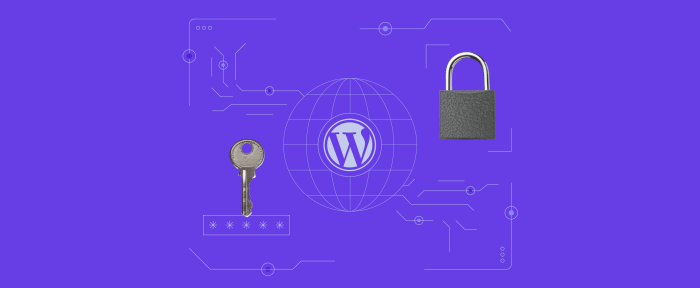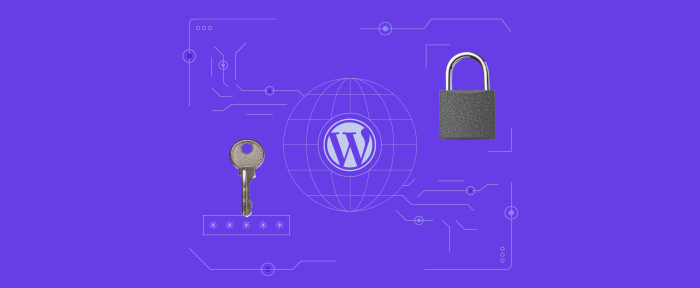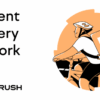Is WordPress a security concern? This question dives into the often-debated topic of website security when using WordPress. From its widespread popularity as a content management system to the potential vulnerabilities it presents, this exploration uncovers the multifaceted nature of WordPress security. We’ll examine the system’s architecture, common threats, built-in defenses, and practical mitigation strategies to understand the risks and rewards of choosing WordPress for your website.
WordPress powers millions of websites globally, making it a popular choice for individuals and businesses. However, this widespread adoption also brings potential security concerns. This detailed exploration examines the security landscape surrounding WordPress sites, discussing the built-in protections, potential vulnerabilities, and strategies for maintaining a secure platform. We’ll also look at the importance of regular updates, strong passwords, and choosing reliable hosting providers.
Introduction to WordPress Security
WordPress is a powerful and popular open-source content management system (CMS) used to build websites and blogs. Its ease of use, vast plugin ecosystem, and extensive community support have made it a favorite among individuals and businesses alike. From simple personal blogs to complex e-commerce stores, WordPress powers a significant portion of the online world.The typical WordPress website architecture involves a central database that stores website content, a set of files (often themes and plugins) that dictate the website’s appearance and functionality, and a web server that hosts and delivers these files to visitors.
Security vulnerabilities can arise at any point in this process, impacting the entire website.
WordPress Website Architecture
WordPress websites are built upon a three-tiered architecture. The presentation layer (web browser) interacts with the application layer (WordPress core, themes, and plugins) which, in turn, interacts with the data layer (database). This architecture can be a source of vulnerabilities if not properly secured.
Common Security Threats Targeting WordPress
WordPress websites face a range of security threats, including malware attacks, SQL injection vulnerabilities, cross-site scripting (XSS) attacks, and brute-force attacks. These threats exploit weaknesses in the WordPress core, themes, plugins, or the website’s configuration to compromise the system or steal sensitive information. Understanding these threats is crucial for implementing effective security measures.
Common WordPress Vulnerabilities
A comprehensive understanding of common vulnerabilities is critical for proactive security measures. This table Artikels some of the most frequent vulnerabilities that WordPress websites are susceptible to.
| Vulnerability Type | Description | Example |
|---|---|---|
| SQL Injection | Attackers exploit vulnerabilities in the database interaction to execute malicious SQL queries. | Malicious input altering database queries to retrieve sensitive data or modify data. |
| Cross-Site Scripting (XSS) | Attackers inject malicious scripts into web pages viewed by other users. | Maliciously crafted input displaying harmful scripts on user pages. |
| File Inclusion Vulnerabilities | Attackers exploit vulnerabilities in file handling to include malicious files. | Manipulating file inclusion paths to load and execute harmful code. |
| Brute-Force Attacks | Repeated attempts to guess usernames and passwords. | Automated tools trying to guess user credentials. |
| Plugin/Theme Vulnerabilities | Outdated or vulnerable plugins and themes are often targets for exploits. | A compromised plugin enabling attackers to gain unauthorized access. |
WordPress Security Measures: Is WordPress A Security Concern
WordPress, while a powerful platform, is susceptible to security threats like any other system. Robust security practices are crucial for maintaining a safe and reliable website. This section delves into the built-in safeguards, the importance of updates, plugin effectiveness, and essential configurations.WordPress itself incorporates several layers of security. These measures, combined with proactive user actions, can significantly reduce vulnerabilities.
Careful configuration and understanding of these methods are vital for safeguarding your website.
Built-in WordPress Security Features
WordPress has inherent security features designed to deter common attacks. These features include automatic updates, user roles and permissions, and built-in protection against SQL injection. A strong understanding of these features allows for better mitigation of security risks.
Importance of Regular Updates and Security Patches
Regular updates are paramount to maintaining a secure WordPress site. They often include crucial security patches that address vulnerabilities discovered by the WordPress community and security researchers. Failure to apply these updates leaves your site exposed to potential exploits. For example, a recent patch addressed a critical flaw in the core WordPress file handling. This flaw, if unpatched, could have allowed attackers to inject malicious code.
Comparison of Security Plugin Effectiveness
Numerous security plugins are available for WordPress, each with varying degrees of effectiveness. Choosing the right plugin requires careful consideration of your specific needs and technical expertise. A plugin’s ability to prevent common attacks and provide detailed logging is key. Some plugins offer advanced features like malware scanning, while others focus on basic protection.
Comparison Table of WordPress Security Plugins
| Plugin Name | Key Features | Pros | Cons |
|---|---|---|---|
| Wordfence | Firewall, malware scanning, intrusion detection | Comprehensive protection, good reputation | Can be resource-intensive |
| Sucuri | Website scanning, malware removal, security monitoring | Strong reputation, reliable support | Can be expensive for basic use |
| iThemes Security | Security hardening, brute force protection, and malware scanning | Wide range of features, good support | Can be overwhelming for beginners |
Strong Passwords and User Accounts
Robust user accounts are essential for a secure WordPress site. This includes creating strong passwords that are difficult to crack. The complexity of the password directly correlates to its resistance against brute-force attacks. Password managers can assist in generating and remembering strong passwords. Furthermore, limiting user privileges to only necessary roles significantly restricts potential damage from unauthorized access.
Best Practices for User Authentication
Best practices for user authentication involve implementing multi-factor authentication (MFA). MFA adds an extra layer of security by requiring users to provide multiple forms of verification. This makes it considerably harder for attackers to gain access even if they have a compromised password. Additionally, regular account reviews and password changes are crucial for maintaining security.
Role of a Firewall in Protecting a WordPress Site
A firewall acts as a protective barrier between your WordPress site and the internet. It controls incoming and outgoing traffic, blocking suspicious requests and protecting your site from various attacks. The firewall’s effectiveness hinges on proper configuration and ongoing monitoring.
Configuring a Firewall for WordPress
Configuring a firewall for WordPress involves specifying rules to control traffic. These rules determine which requests are allowed and which are blocked. For example, rules can be set to block malicious IP addresses or suspicious user agents. A well-configured firewall can effectively prevent unauthorized access and safeguard your website.
Common Security Risks to WordPress
WordPress, a powerful platform for building websites, is vulnerable to various security threats. While robust in its core functionality, the sheer number of plugins and themes, coupled with user interaction, creates avenues for exploitation. Understanding these risks is crucial for website owners to implement effective security measures.Understanding common vulnerabilities allows for proactive security measures, mitigating potential harm and safeguarding your website’s integrity.
Protecting your WordPress site requires recognizing the weaknesses that attackers exploit and understanding the potential consequences.
SQL Injection
SQL injection vulnerabilities arise when user input is not properly sanitized before being used in SQL queries. Attackers can inject malicious SQL code, manipulating database queries to gain unauthorized access to sensitive information, or even execute commands that compromise the entire system. This can lead to data breaches, unauthorized modifications, or even complete website takeover. A simple example is submitting data that appends malicious code into a login query, effectively bypassing authentication.
Cross-Site Scripting (XSS)
Cross-site scripting (XSS) attacks involve injecting malicious scripts into websites viewed by other users. These scripts can steal user data, redirect users to malicious sites, or deface the website. This often happens when user input is not properly validated or encoded before being displayed on a webpage. For instance, an attacker might inject JavaScript code into a comment field, which would then execute on the browser of anyone viewing that comment.
Malware and Malicious Code Injection
Malware and malicious code injection threats involve the introduction of harmful software into a WordPress site. This can happen through compromised plugins, themes, or even through direct file uploads. The consequences can range from data breaches to complete website defacement. Malicious code can be disguised as legitimate files, exploiting vulnerabilities to gain access. This is often spread through malicious plugins or themes.
Theme and Plugin Vulnerabilities
Themes and plugins, essential extensions for WordPress functionality, can contain vulnerabilities. Outdated or poorly coded themes and plugins are particularly susceptible. Attackers often target these vulnerabilities to gain unauthorized access to the website. Keeping plugins and themes updated is a critical security measure.
User Input Validation
User input validation is paramount for mitigating many security risks. Validating user input ensures that only expected data is processed, preventing malicious code injection and other vulnerabilities. This includes checking for appropriate data types, lengths, and formats. Thorough validation significantly reduces the attack surface.
Summary of Common WordPress Vulnerabilities
| Vulnerability | Description | Impact |
|---|---|---|
| SQL Injection | Malicious code injected into SQL queries. | Data breaches, unauthorized access, system compromise. |
| Cross-Site Scripting (XSS) | Malicious scripts injected into website content. | Data theft, redirection to malicious sites, website defacement. |
| Malware and Malicious Code Injection | Harmful software introduced into the website. | Data breaches, website defacement, system compromise. |
| Theme/Plugin Vulnerabilities | Outdated or poorly coded themes/plugins. | Unauthorized access, system compromise. |
Mitigation Strategies for WordPress Security Risks
WordPress, while a powerful platform, is vulnerable to various security threats. Understanding and implementing robust mitigation strategies is crucial for maintaining a secure and reliable website. This section delves into practical methods for bolstering your WordPress site’s defenses against common attacks.
Protecting Against SQL Injection Attacks
SQL injection vulnerabilities occur when malicious code is injected into SQL queries. This can allow attackers to manipulate data, gain unauthorized access, or even delete critical information. Preventing SQL injection requires meticulous validation of all user input. This includes sanitizing user-submitted data before it interacts with the database. WordPress’s built-in functions, like `esc_sql()`, should be used consistently to ensure that input is properly escaped.
Developers should also employ parameterized queries whenever possible. This approach separates the SQL command from the user input, making it significantly harder for malicious code to be interpreted as part of the query. Properly configured firewalls can also serve as an additional layer of defense.
Preventing Cross-Site Scripting (XSS) Attacks
Cross-site scripting attacks exploit vulnerabilities in websites to inject malicious scripts into web pages viewed by other users. To mitigate this, ensure all user-supplied data is properly sanitized and encoded. Use WordPress’s built-in functions like `esc_html()` and `esc_url()` to sanitize HTML and URLs, respectively. This prevents potentially harmful scripts from executing on the website. Input validation, where data is checked for expected formats, is also a key preventative measure.
Furthermore, web application firewalls (WAFs) can filter out potentially harmful script tags, offering another level of protection.
Detecting and Removing Malicious Code
Malicious code can be introduced into a WordPress website through various means, including compromised plugins or themes. Regularly checking for suspicious code changes is vital. Tools and plugins dedicated to scanning for malware should be used. This helps in detecting and eliminating malicious code. Reviewing website logs for unusual activity, like unusual file changes, is a crucial part of this proactive approach.
Employing security plugins and tools specifically designed for malware detection can automatically scan for threats and quarantine or remove malicious files.
Securing WordPress User Accounts
Strong passwords, multi-factor authentication (MFA), and regular account reviews are essential for user account security. Enforce strong password policies, including length and complexity requirements. Implement MFA to add an extra layer of security. Regularly review user accounts, looking for suspicious activity or inactive accounts that may have been compromised. Restricting user roles and permissions based on their needs limits potential damage if an account is compromised.
The Role of Regular Backups in Maintaining Site Security
Regular backups are a critical aspect of WordPress security. They provide a recovery point in case of a security breach, malware infection, or accidental data loss. Automated backups, ideally performed daily, are highly recommended. Backing up databases and all website files is essential. Storing backups off-site is crucial to prevent data loss in case of physical damage to the primary server.
So, is WordPress a security concern? Honestly, it depends. Properly configured, it’s usually pretty robust. But handling client expectations and keeping your site up-to-date is crucial, just like how how to work with clients effectively is key to your overall success. Ultimately, good security practices are essential, regardless of the platform.
If you’re unsure, it’s always best to consult with a professional.
This approach provides a safety net against unforeseen incidents.
Choosing Secure Hosting Providers
Choosing a secure hosting provider is paramount. A reputable provider employs robust security measures, including firewalls, intrusion detection systems, and regular security audits. Look for providers that offer security features like automatic updates, malware scanning, and intrusion prevention systems. Understanding their security practices and infrastructure is essential when selecting a hosting provider.
Mitigation Strategies Effectiveness
| Mitigation Strategy | Effectiveness | Description |
|---|---|---|
| SQL Injection Prevention | High | Using parameterized queries, sanitizing user input, and using prepared statements. |
| XSS Prevention | High | Escaping user input, using appropriate filters, and validating user input. |
| Malware Detection | Medium | Regular scans, review of logs, use of security plugins. |
| User Account Security | High | Strong passwords, MFA, account reviews, role restrictions. |
| Regular Backups | High | Daily automated backups, off-site storage. |
| Secure Hosting | High | Reputable providers with robust security measures, intrusion detection, and regular audits. |
The Impact of Poor Security Practices

Poor security practices on WordPress websites can have devastating consequences, ranging from financial losses to severe reputational damage and even legal repercussions. Understanding these potential impacts is crucial for website owners to prioritize security measures. Ignoring these risks can lead to substantial costs and erode trust with users.A strong security posture is not just about preventing attacks; it’s about protecting the financial well-being and reputation of your business.
This section delves into the real-world consequences of neglecting WordPress security, highlighting the importance of proactive security measures.
While WordPress security concerns are sometimes debated, a strong understanding of security best practices is key. Interactive content, like polls and quizzes, can boost user engagement significantly, as demonstrated in 7 ways to include interactive content to amplify engagement here. Ultimately, prioritizing security measures alongside engaging content creation is crucial for any WordPress site.
Examples of Websites Affected by Security Breaches
Numerous high-profile WordPress websites have fallen victim to security breaches. These breaches, often resulting from vulnerabilities in plugins or themes, can expose sensitive user data, compromise website functionality, and damage the site’s reputation. Examples include news outlets, e-commerce platforms, and even small businesses. The consequences of these incidents can be severe and far-reaching.
Financial Damage Caused by Breaches
Security breaches can inflict significant financial damage. This damage extends beyond the immediate costs of remediation. Loss of customer trust can lead to a decline in sales and revenue. Website downtime due to attacks or security issues can result in lost business opportunities and revenue. The cost of restoring website functionality, implementing security measures, and potentially compensating affected users can be substantial.
Reputational Damage Caused by Breaches
The reputational damage resulting from a security breach can be catastrophic for a business. A loss of trust from customers, investors, and the public can have long-term consequences. Customers may hesitate to do business with a site known to be vulnerable. The breach can lead to a loss of brand value and damage the organization’s standing in the market.
Legal Implications of Security Failures
Security failures can lead to legal liabilities. If a security breach compromises user data, the website owner might face legal action from affected users. Compliance with data privacy regulations, like GDPR, is paramount. Failure to implement adequate security measures can lead to significant legal penalties and fines.
Importance of Regular Security Audits
Regular security audits are crucial to identify and address potential vulnerabilities before they are exploited. These audits help assess the overall security posture of a website. This proactive approach can minimize the risk of breaches and associated damages.
Potential Costs Associated with Different Security Breaches
| Type of Breach | Estimated Cost (USD) | Description |
|---|---|---|
| Data Breach (Sensitive User Data) | $100,000 – $1,000,000+ | Exposure of customer information, including credit card details, addresses, or other sensitive information. |
| Website Defacement | $5,000 – $50,000 | Compromising website aesthetics and displaying malicious content. |
| Malware Infection | $1,000 – $100,000+ | Installation of malicious software, impacting website functionality and potentially data. |
| Denial-of-Service Attack | $1,000 – $100,000+ | Making a website unavailable to users by overwhelming it with traffic. |
Note: These are estimated costs and can vary significantly depending on the severity of the breach, the extent of damage, and the measures taken to recover.
Staying Up-to-Date with WordPress Security
WordPress, a powerful platform, relies on a constant stream of updates to maintain its security posture. Staying informed about these updates and actively implementing them is crucial for protecting your website from emerging threats. Ignoring security advisories can leave your site vulnerable to exploitation, leading to data breaches, downtime, and reputational damage.Regular updates address vulnerabilities that hackers actively seek to exploit.
These updates often include patches for known security flaws, strengthening the core platform and plugins. Understanding how to identify and apply these updates is vital to mitigating potential risks.
Importance of Following WordPress Security News
Staying abreast of WordPress security news is essential for proactive website protection. Knowing about emerging threats allows you to address vulnerabilities before they are exploited. This proactive approach is far more effective than reacting to incidents after they occur. Keeping up-to-date ensures your website remains a strong, resilient presence online.
Identifying and Verifying Security Updates
WordPress provides clear channels for identifying and verifying security updates. The official WordPress website, along with trusted community forums and security blogs, publish details on security advisories. These advisories typically include a description of the vulnerability, the affected components (core, plugins, themes), and instructions on how to apply the update. Always cross-reference information from multiple sources to ensure accuracy.
Resources for Staying Informed
Staying informed about WordPress security involves subscribing to reputable sources. This ensures you receive timely updates about new threats and vulnerabilities, enabling you to address them before they can be exploited.
While WordPress security concerns are often debated, robust security practices are key. Modern tools like Google Analytics, with its automated reporting features (like those detailed in google analytics making use automated reports ), can help website owners stay ahead of potential issues. Ultimately, a strong WordPress site depends on more than just the platform itself; diligent maintenance and security protocols are vital.
- The official WordPress.org security blog provides detailed information about security issues and updates.
- Security blogs and forums dedicated to WordPress often publish insightful analyses and discussions of new threats.
- Security newsletters and email alerts from reliable WordPress security resources offer timely updates.
- Following security experts and community leaders on social media platforms can keep you informed about important announcements.
Key Resources for WordPress Security Information
Regularly checking these resources is crucial for maintaining a secure WordPress site.
| Resource | Description |
|---|---|
| WordPress.org Security Blog | Official source for security advisories, updates, and news. |
| Wordfence Security Blog | Provides comprehensive insights into WordPress security threats and mitigation strategies. |
| Sucuri Blog | Offers expert opinions, research, and analysis on WordPress security topics. |
| MalCare Blog | Provides actionable advice on identifying and fixing vulnerabilities. |
| Other reputable security blogs and forums | Various community-driven sources dedicated to WordPress security. |
Illustrative Case Studies

WordPress, despite its popularity, is not immune to security threats. Understanding past incidents, their causes, and how they were mitigated is crucial for bolstering WordPress security practices. This section delves into specific case studies to highlight the importance of vigilance and proactive measures.Recent years have witnessed a surge in sophisticated attacks targeting WordPress websites. These attacks often exploit vulnerabilities in plugins, themes, or the core WordPress software itself.
By examining these incidents, we can gain valuable insights into the tactics used by attackers and, more importantly, learn how to prevent such breaches in the future.
A Recent WordPress Security Incident
A recent security incident involved a popular WordPress theme widely used by bloggers. A critical vulnerability in the theme’s code allowed attackers to inject malicious scripts into websites using it. This vulnerability, stemming from a flaw in how the theme handled user input, allowed attackers to execute arbitrary code on compromised websites.
Vulnerabilities Leading to the Incident
The vulnerability stemmed from a lack of input validation in the theme’s code. The theme’s developers failed to properly sanitize user-submitted data, enabling attackers to insert malicious code disguised as legitimate input. This allowed them to execute arbitrary commands and potentially gain unauthorized access to sensitive data.
Preventable Measures
The incident could have been avoided through several preventative measures:
- Robust input validation: Implementing strict input validation would have prevented attackers from injecting malicious code. This would have required careful checks on the type, length, and format of all user-submitted data.
- Regular security audits: Conducting regular security audits of the theme’s code would have identified the vulnerability before it was exploited.
- Proactive security updates: The theme’s developers should have issued a prompt and comprehensive security update addressing the vulnerability.
Lessons Learned
The incident underscores the importance of proactive security measures for WordPress themes and plugins. Developers must prioritize security audits, input validation, and regular updates to mitigate vulnerabilities. This incident also highlights the need for website owners to install security plugins and regularly update WordPress core, plugins, and themes.
Comparison of Vulnerabilities and Mitigation Strategies
| Case Study | Vulnerability Type | Mitigation Strategy |
|---|---|---|
| Popular Theme Exploit | Lack of input validation; insecure handling of user-submitted data | Implement robust input validation; conduct regular security audits; release prompt security updates |
| Outdated Plugin | Known vulnerabilities in an outdated plugin | Update plugins to the latest versions; use a plugin security scanner; evaluate plugin security regularly |
| Weak Passwords | Use of weak or default passwords for WordPress accounts | Implement strong password policies; use two-factor authentication; change default passwords; regularly audit passwords |
Building a Secure WordPress Site
Protecting your WordPress site is crucial for maintaining its functionality and safeguarding your data. A robust security strategy involves proactive measures, regular maintenance, and a deep understanding of potential threats. Ignoring security can lead to data breaches, financial losses, and reputational damage.A secure WordPress site is built on layers of defense, from choosing strong passwords to regularly updating core components.
This approach ensures your site remains resilient against evolving threats. Implementing these steps is essential to mitigate risks and ensure your site remains a trusted platform.
Securing a New WordPress Site
Establishing a secure foundation from the outset is vital. This involves meticulous attention to detail in every step of the setup process.
- Choose a strong, unique username and password. Avoid easily guessable combinations like birthdays or names. Employ a password manager for secure storage and generation of strong, unique passwords. Consider using two-factor authentication (2FA) to add an extra layer of protection.
- Select a secure hosting provider. A reputable host with robust security measures will significantly reduce your vulnerabilities. Look for providers offering regular security audits and updates, as well as appropriate firewall configurations.
- Install a strong firewall. A firewall acts as a barrier, filtering unwanted traffic and blocking malicious attempts to access your site. This step is critical in preventing unauthorized access and exploits.
- Use a secure domain name. A trustworthy domain name provider enhances the site’s security. This ensures your domain is correctly registered and configured to avoid impersonation.
Installing and Configuring Security Plugins
WordPress plugins offer numerous security enhancements. Careful selection and configuration are essential for optimal protection.
- Thoroughly research plugins. Before installing, scrutinize the plugin’s reputation, user reviews, and security ratings. Verify that the plugin aligns with your specific security needs.
- Install reputable plugins. Choose plugins from trusted developers with a proven track record of security. Avoid plugins with questionable reviews or suspicious origins.
- Actively monitor and update plugins. Keep your security plugins up-to-date to address vulnerabilities. Regular updates often include crucial security patches.
- Configure plugin settings. Carefully review and adjust plugin settings to limit access and enhance security. Avoid default settings that could expose your site to risks.
Regular Theme and Plugin Updates, Is wordpress a security concern
Keeping your WordPress core, themes, and plugins updated is a cornerstone of security.
- Implement an automatic update system. Enable automatic updates whenever possible to ensure you’re always running the latest versions.
- Check for updates regularly. Schedule time to manually check for updates, especially for critical security patches.
- Understand the importance of updates. Updates frequently contain critical security fixes that prevent exploits and vulnerabilities.
Protecting Against Brute-Force Attacks
Brute-force attacks are automated attempts to guess usernames and passwords. Implementing effective measures is critical.
- Use strong passwords. This is the first line of defense. Use strong, unique passwords that are difficult to guess.
- Implement a login security plugin. Plugins can limit login attempts, add lockout periods, and prevent brute-force attacks. These are critical in thwarting automated attacks.
- Use a strong firewall. A firewall helps filter out malicious traffic trying to access your site.
Implementing Security Best Practices
A structured approach is essential to establishing and maintaining a secure WordPress site.
- Regularly back up your website. Data backups are crucial for restoring your site in case of unforeseen issues or attacks.
- Use strong, unique passwords. This is essential to prevent unauthorized access.
- Limit user access. Grant only necessary permissions to users. This principle minimizes the potential impact of a compromised account.
- Employ security scans. Utilize tools to scan for vulnerabilities and address them promptly.
Essential Security Steps Summary
| Step | Description |
|---|---|
| Strong Passwords | Use unique, complex passwords. |
| Regular Updates | Keep core, themes, and plugins updated. |
| Security Plugins | Install and configure reliable security plugins. |
| Firewall | Implement a strong firewall. |
| Backup | Regularly back up your website. |
Final Thoughts
In conclusion, while WordPress is a powerful platform, it’s crucial to understand its security implications. By understanding the common threats, implementing robust security measures, and staying informed about emerging vulnerabilities, you can significantly mitigate risks and maintain a secure WordPress site. Regular updates, vigilant security plugin use, and proactive security audits are essential for long-term safety.






